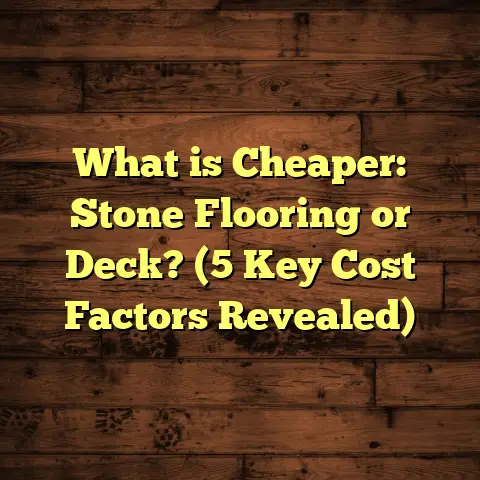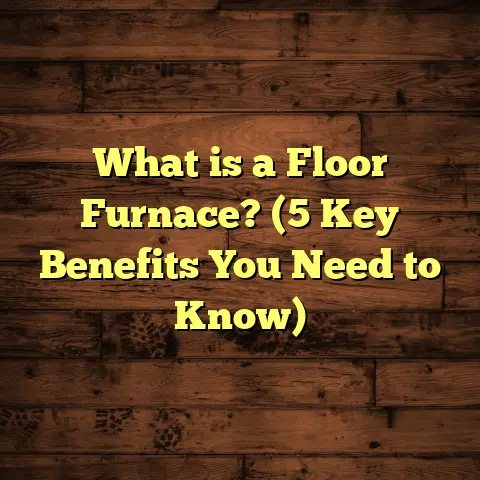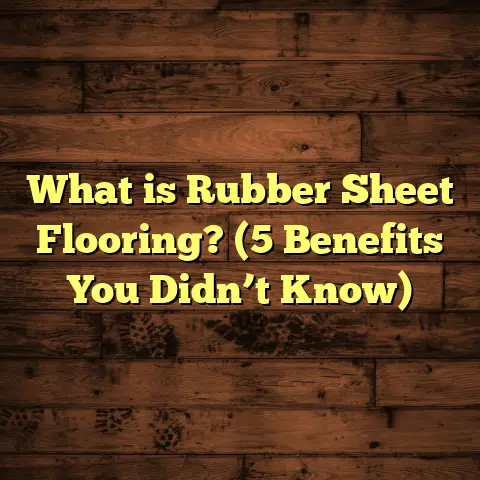What is Wood-Look Rubber Flooring? (5 Benefits You Must Know)
Have you ever walked into a home and immediately felt that warm, inviting vibe that only wood floors can bring? I know I have. There’s just something about the natural grain, the soft hues, and the way light plays on those surfaces that can make a space feel cozy and timeless. But what if you want that look without all the usual headaches of hardwood? Maybe you’ve had bad experiences with scratches, water damage, or expensive upkeep. That’s where wood-look rubber flooring steps in—a surprisingly versatile and practical option I’ve come to really appreciate over the years.
What is Wood-Look Rubber Flooring?
Let me start with the basics. Wood-look rubber flooring is a type of flooring designed to imitate the appearance of natural wood while being made primarily from rubber materials. It’s crafted to resemble everything from oak to maple planks, complete with textured grains and color variations that replicate real wood closely. But underneath all that visual detail lies a durable rubber core.
This means you get the aesthetics of wood but benefit from rubber’s unique properties like shock absorption, water resistance, and ease of maintenance. The flooring typically comes in planks or tiles, installed much like vinyl or rubber mats.
It’s an ideal choice for spaces where durability and comfort are just as important as style—gyms, schools, healthcare facilities, and increasingly in homes.
Why Did I Start Using Wood-Look Rubber Flooring?
The first time I encountered wood-look rubber flooring was on a commercial project for a daycare center. The client wanted something warm and welcoming but also safe for kids who’d be running around all day. Hardwood floors were out of the question because of safety concerns and the high maintenance involved. After testing samples and doing my homework, I recommended wood-look rubber flooring.
The installation was surprisingly straightforward — which was a relief because the project timeline was tight. The kids loved how soft it felt underfoot and staff appreciated how easy it was to clean up spills and messes.
Over time, I noticed that despite heavy foot traffic and daily wear-and-tear, the floor showed barely any signs of damage. This sparked my curiosity, so I started using this flooring on residential projects too. It quickly became my go-to recommendation for clients wanting the look of wood without its usual fragility.
What Is It Made Of?
Most wood-look rubber floors are made from a combination of synthetic or natural rubber combined with pigments and binders. Some use recycled rubber from used tires or other products, making them eco-friendly choices. The surface layer is often printed with detailed wood grain patterns using advanced printing technology to achieve realistic visuals.
The thickness can vary from around 3mm to 6mm or more depending on the product and intended use. Thicker options provide more cushioning and durability but cost more.
5 Benefits You Must Know About Wood-Look Rubber Flooring
I want to share five key advantages that have made me favor this flooring in many projects.
1. Durability That Handles Life’s Messes
Rubber floors are famously resilient, but wood-look rubber floors take durability even further by combining a tough rubber base with a protective wear layer.
One client had an active dog who loved chewing on anything within reach. If she had hardwood floors, she would’ve faced scratches and gouges almost instantly. Instead, her rubber floor remained pristine after two years of daily paw traffic.
According to Flooring Industry Alliance (FIA) data, rubber flooring can last up to 15 years in high-traffic residential settings with minimal upkeep, compared to 5-7 years for hardwood in similar situations.
The wear layer on these floors resists abrasion, impact damage, and stains better than most other options. This makes it ideal for busy households with kids, pets, or lots of visitors.
2. Comfort Underfoot and Noise Reduction
Standing on hard floors all day can tire your feet — I definitely know this from experience working long hours on various job sites. Rubber flooring offers soft cushioning that reduces fatigue significantly.
This softness also absorbs sound effectively. In an apartment renovation I worked on, replacing noisy laminate floors with wood-look rubber drastically reduced footstep noise between units. Tenants reported much quieter living conditions — something that’s hard to achieve otherwise without expensive soundproofing layers.
Studies show these floors can reduce impact noise by 20-25 decibels compared to hardwood or laminate — great news if you live in a multi-story building or want a peaceful home environment.
3. Waterproof and Easy to Clean
If you’re like me and often spill coffee or drop food accidentally (or your kids do!), you’ll appreciate that wood-look rubber flooring is completely waterproof.
Unlike hardwood or laminate floors that warp or swell when exposed to moisture, rubber floors stand up to water without damage. This makes them perfect for kitchens, bathrooms, mudrooms, basements — any place where moisture is a constant challenge.
Cleaning is a breeze too — just sweep or mop with mild soap and water. No special cleaners needed, no worries about damaging the finish.
One client who installed this flooring in her basement laundry room loved how quickly she could wipe up detergent spills without worrying about stains or warping.
4. Eco-Friendly Options Available
Sustainability is increasingly important to me as a contractor who cares about environmental impact. Many manufacturers now produce wood-look rubber flooring using recycled materials such as reclaimed tires or synthetic rubbers.
One brand I work with uses 50% post-consumer recycled content in their products, plus low-VOC adhesives to improve indoor air quality during installation. This reduces landfill waste and carbon footprint compared to traditional hardwood that requires logging and energy-intensive processing.
If you’re looking for “green” flooring options but want something durable and stylish, recycled rubber floors are a smart choice.
5. Cost-Effective Over Time
While initial costs for wood-look rubber flooring can be comparable to mid-range hardwood or luxury vinyl plank (LVP), the long-term savings stand out.
Less maintenance means no costly refinishing or repairs down the road. And because these floors last longer under heavy use without needing replacement, you avoid repeated expenses.
A commercial gym I worked with switched from hardwood to wood-look rubber flooring and saved over $15,000 in maintenance costs over five years alone.
For homeowners on a budget who want high performance without sacrificing appearance, this makes great financial sense.
Sharing Successes From Real Projects
Let me tell you about some projects where wood-look rubber flooring really shined:
- Daycare Center: On that first project I mentioned, the client was thrilled with not only the look but also how safe it felt for toddlers running around. The floor cushioned falls better than any hardwood or vinyl could. Maintenance staff praised how quick cleanup was after snack time messes.
- Pet Owner’s Home: Another client adopted two large dogs after installing this floor in their living room. She told me she no longer worried about scratches or muddy paws marking up the floor after walks.
- Apartment Building: Replacing noisy laminate with rubber planks between floors cut noise complaints drastically. Residents enjoyed quieter bedrooms and living spaces without adding expensive soundproofing materials.
- Aging-in-Place Renovation: For an elderly couple renovating their home for safety, the cushioning effect helped reduce fall risks and improved comfort during long periods standing at kitchen counters.
- Commercial Gym: Heavy weights dropped daily left no marks on the durable surface while mimicking warm wooden aesthetics instead of cold concrete or plain rubber mats.
Problems and Challenges I’ve Faced
Nothing is perfect though, right? Here are some issues I’ve encountered:
- Limited Color Variety: Compared to natural wood which comes in countless species and finishes, wood-look rubber floors have fewer color options. Although manufacturers keep improving textures and shades, customization isn’t quite there yet.
- Installation Prep: Rubber flooring needs a very flat subfloor for proper installation without gaps or bubbles. In older homes with uneven surfaces, preparing this took extra time and cost.
- Warmth Factor: Rubber tends to hold heat more than wood or tile which can feel unusual in hot climates or summer months.
- Fading Risk: Prolonged exposure to direct sunlight may cause slight fading over many years—though less than some vinyl products.
- Perceived Value: Some clients initially hesitate due to misconceptions about rubber floors feeling “cheap” or “industrial.” Showing samples helps overcome this doubt quickly.
Deeper Into Data: What Studies Say
Here’s some detailed info backed by research:
| Feature | Wood-Look Rubber Flooring | Hardwood Flooring | Laminate Flooring |
|---|---|---|---|
| Abrasion Resistance | High (Wear Layer ASTM D4060) | Moderate | Moderate |
| Impact Sound Reduction | 20-25 dB | 5-10 dB | 10-15 dB |
| Water Resistance | Nearly 100% | Low | Low-Medium |
| Maintenance Cost (Annual) | <$0.50/sq ft | $2-$3/sq ft | $1-$1.50/sq ft |
| Lifespan (Residential Use) | 10-15 years | 5-7 years | 5-8 years |
| Eco-Friendly Content | Up to 50% recycled | None | None |
These numbers come from various industry reports including Flooring Industry Alliance studies and manufacturer technical sheets.
Installation Insights and Tips
If you’re thinking about installing wood-look rubber flooring yourself or hiring professionals like me, here are some pointers:
- Subfloor Prep Matters: Ensure your subfloor is clean, dry, level (within 3mm over 3m), and free of debris before installation.
- Acclimate Flooring: Let planks acclimate in your space for at least 48 hours before installation so they adjust to temperature/humidity.
- Use Proper Adhesives: Choose adhesives recommended by manufacturers specializing in rubber floors with low VOCs.
- Expansion Gaps Needed: Leave small gaps around edges for expansion/contraction due to temperature changes.
- Seam Sealing Optional: Some products allow sealing seams for extra moisture protection especially in wet areas.
- Tools Required: Utility knife for cutting planks; roller for ensuring adhesion; straight edge for precise cuts.
- Professional Help Recommended: Especially if your subfloor needs leveling or if you want warranty coverage.
Care and Maintenance
One huge selling point is how easy it is to care for this floor type:
- Sweep regularly with a soft broom to remove dirt/grit.
- Mop occasionally using mild soap and water; avoid harsh chemicals.
- Wipe spills immediately but no stress if left a short time—rubber resists staining.
- Use furniture pads under heavy pieces to prevent indentations.
- Avoid dragging sharp objects across surface.
- Inspect periodically for edge lifting or bubbles—these are rare but worth catching early.
Comparing Wood-Look Rubber Flooring With Alternatives
Why choose this over other popular options?
| Feature | Wood-Look Rubber Flooring | Hardwood | Luxury Vinyl Plank (LVP) |
|---|---|---|---|
| Visual Authenticity | Very High | Highest | High |
| Comfort | Excellent | Moderate | Moderate |
| Water Resistance | Excellent | Poor | Good |
| Durability | Excellent | Moderate | Good |
| Maintenance | Low | High | Moderate |
| Noise Reduction | Excellent | Poor | Moderate |
| Eco-Friendliness | High (recycled content) | Low | Varies |
| Cost (Initial) | Mid-range | High | Mid-range |
This table can help narrow down your choice based on lifestyle needs.
Personal Stories From Clients
I remember one family whose teenage son played basketball indoors (yes, indoors!). Hardwood wasn’t an option because of damage risk and noise complaints from neighbors below were frequent. We installed wood-look rubber flooring instead — he loved the “bounce” underfoot for practicing moves while mom appreciated the quiet living space afterward.
Another story comes from an artist who works with messy paints — she found cleaning up spills effortless compared to scrubbing stained wooden floors in her previous studio.
Frequently Asked Questions
Q: Can wood-look rubber flooring be installed over radiant heating?
A: Yes! Many brands are compatible with radiant heat systems but always check manufacturer specs first.
Q: How does it handle UV exposure?
A: Most products resist fading well but prolonged direct sunlight may cause some color change over many years.
Q: Is it suitable for outdoor use?
A: Not usually recommended outdoors due to temperature fluctuations affecting adhesives and material stability.
Q: Can I install it myself?
A: If you’re handy with tools and follow instructions carefully, yes—but professional installation ensures best results especially on uneven subfloors.
Q: How do I remove stains?
A: Most stains wipe away easily with mild soap; avoid abrasive cleaners or scrubbing pads which could damage surface texture.
Wrapping Up My Thoughts
After working extensively with various flooring types over many years,
wood-look rubber flooring stands out as a smart choice for those wanting warmth,
durability,
comfort,
and ease—all wrapped up in one package that looks surprisingly like real wood.
I’ve seen it perform exceptionally well in homes with kids,
pets,
high foot traffic,
and even commercial spaces demanding toughness without sacrificing style.
If you’re tired of worrying about scratches,
water damage,
or noise complaints,
this might just be the solution you’ve been looking for.
Feel free to ask me if you want advice on brands,
installation tips,
or whether this flooring fits your particular project needs!
Would you be interested in trying it out? Or maybe you’ve already had some experience? Let’s chat!
If you want me to add even more detail on specific brands,
installation methods,
or case studies,
just let me know!





